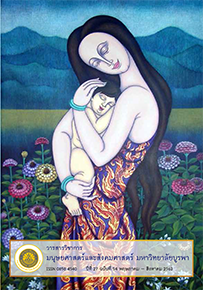Gender Ideology in the New Words Royal Institute Dictionary Volume 1-2: A Critical Discourse Analysis Gender Ideology in The New Words Royal Institute Dictionary Volume 1-2 : A Critical Discourse Analysis.
Main Article Content
Abstract
The research aimed to study sexual ideology through the linguistic expression in sentences used in the New Words Royal Institute Dictionary Volumes 1-2. The theory used is a Critical Discourse Analysis Approach. The objectives of this research are to classify and categorize the sexual ideology, to analyze the communication strategy and a group of ideas in sexual ideology and to figure out the dissemination of discourse and the practice of discourse that represents the Thai society and culture in the dictionary. The research found that there are 3 sexual ideologies: female, male and alternative sex (third gender). Each discourse is composed of 3 sets of ideas. There were 6 linguistic devices that show the gender identity, including the use of idioms, address term, nouns forms, verb forms, extended Calming, rhetorical questions. In term of consumption and dissemination of the discourse, we found that the discourse was disseminated via mass media. This discourse reflects the gender discrimination in Thai society and culture of individual by focusing on the physical condition of gender instead of considering the internal qualities.
Downloads
Article Details
บทความทุกบทความเป็นลิขสิทธิ์ของวารสารวิชาการมนุษยศาสตร์และสังคมศาสตร์ มหาวิทยาลัยบูรพาเท่านั้น
References
คชาธิป พาณิชตระกูล. (2556). ความสัมพันธ์ระหว่างภาษากับอุดมการณ์ว่าด้วยชายรักชายในหนังสือพิมพ์ฉบับรายวันภาษาไทย ปี พ.ศ. 2555: การศึกษาวาทกรรมวิเคราะห์เชิงวิพากษ์. วิทยานิพนธ์อักษรศาสตรมหาบัณฑิต, สาขาภาษาไทย, คณะอักษรศาสตร์, จุฬาลงกรณ์มหาวิทยาลัย.
ทินวัฒน์ สร้อยกุดเรือ. (2558). ภาษากับอัตลักษณ์เมียฝรั่งในวาทกรรมสาธารณะ. วิทยานิพนธ์ปรัชญาดุษฎีบัณฑิต, สาขาวิชาภาษาไทย, คณะมนุษยศาสตร์, มหาวิทยาลัยเกษตรศาสตร์.
วุฒินันท์ แก้วจันทร์เกตุ. (2553). อุดมการณ์ความเป็นชายในวาทกรรมโฆษณาสินค้าและบริการสำหรับผู้ชายในนิตยสารผู้ชาย. วิทยานิพนธ์มหาบัณฑิตอักษรศาสตรมหาบัณฑิต, สาขาภาษาไทย, คณะอักษรศาสตร์, จุฬาลงกรณ์มหาวิทยาลัย.
ราชบัณฑิตยสถาน. (2552). พจนานุกรมคำใหม่ เล่ม 2 ฉบับราชบัณฑิตยสถาน. กรุงเทพฯ: ยูเนียนอุลตร้าไวโอเร็ต.
ราชบัณฑิตยสถาน. (2553). พจนานุกรมคำใหม่ เล่ม 1 ฉบับราชบัณฑิตยสถาน (พิมพ์ครั้งที่ 2). กรุงเทพฯ: ธนาเพรส.
ราชบัณฑิตยสถาน. (2558). พจนานุกรมคำใหม่ เล่ม 1-2 ฉบับราชบัณฑิตยสถาน. กรุงเทพฯ: นานมีบุ๊คส์พับลิเคชั่นส์.
ศิริพร ภักดีผาสุข. (2553). วาทกรรม “ความเป็นผู้หญิง” ในนิตยสารสุขภาพและความงาม. กรุงเทพฯ: สำนักงานคณะกรรมการการอุดมศึกษาและสำนักงานกองทุนสนับสนุนการวิจัย.
de Beauvoir, S. (1952). The second sex. trans. H.M. Parshely. New York: Abfud & Knopf.
Fairclough, N. (1992). Discourse and social change. Cambridge: Polity Press.
Fairclough, N. (1995). Critical discourse analysis. London: Longman.
Hymes, D.H. (1974). Ways of speaking. In R. Bauman & J. Sherzer (Eds.), Explorations in the ethnography of speaking (pp. 433-452). Cambridge: Cambridge University Press.
Machin, D., A. Mayr. (2012). How to do critical discourse analysis. London: California. Singapore, New Delhi: SAGE.


